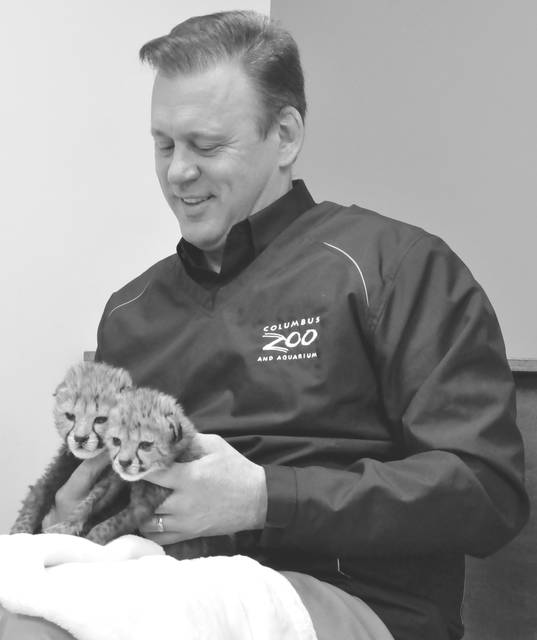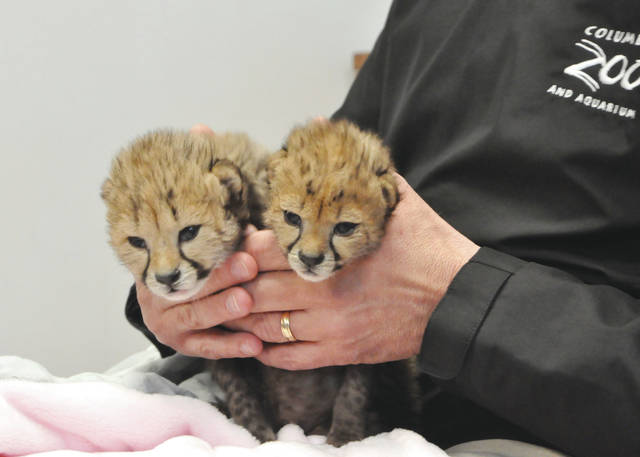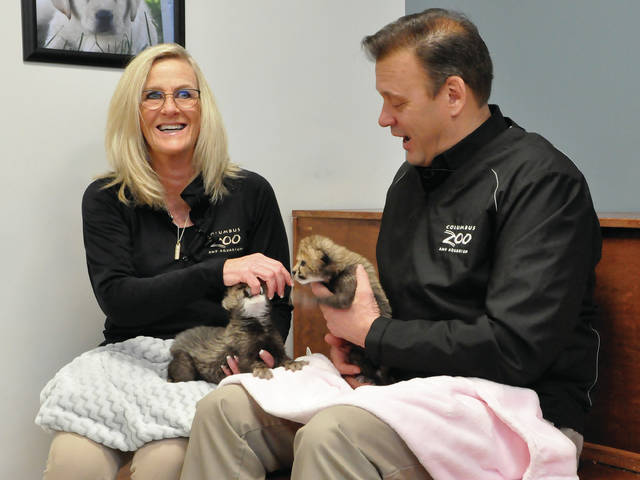


POWELL — Sixteen days ago, history was birthed at the Columbus Zoo and Aquarium in the form of two cheetah cubs. On Friday, the zoo presented the cubs to the public for the first time in a special media session to offer updates on the groundbreaking cubs and the science that led to their arrival.
The two cubs — a male and female who have yet to be named — were born Wednesday, Feb. 19. Their births marked the first time in history that cheetahs were born via in vitro fertilization (IVF) and embryo transfer into a surrogate mother. Through IVF, sperm and eggs are fertilized in a laboratory and then incubated to create embryos. The embryos are then implanted into a female’s womb, where the hope is that the embryos will develop into fetuses.
In this particular case, the cubs’ biological mother is Kibibi, but they were delivered by Isabelle (Izzy), who served as the surrogate cheetah mother.
The Columbus Zoo collaborated with two other leading institutions — Smithsonian’s National Zoo and Conservation Biology Institute in Royal, Virginia, and Fossil Rim Wildlife Center in Glen Rose, Texas — to make the large leap in the preservation of cheetahs a reality.
All previous IVF attempts with cheetahs had been unsuccessful, and with the world’s wild cheetah population continuing to decline, such a breakthrough has become increasingly important to the survival of the species.
“We’re really excited about the fact there was a collaboration with science, and when we talk about why zoos matter, it’s really focused on conservation and population sustainability,” said Columbus Zoo and Aquarium President Tom Stalf on Friday. “Unfortunately, with only 7,500 cheetahs left in the wild, we need to do something.”
Suzi Rapp, vice president of Animal Programs at the Columbus Zoo, said there is a 90% infant mortality rate for cheetah cubs born in the wild, largely because of their need to move around and be active despite being just weeks old. That movement often leads them into harm’s way in the form of predators such as hyenas and leopards. Rapp said no other cats are as mobile at such a young age.
Even when there is human intervention with infant cheetah cubs, Rapp said there is still a 30% mortality rate for various reasons. In this case, she said the female cub struggled to gain weight after birth, which forced them to step in and hand-rear the cubs.
Because mother cheetahs struggles to produce sufficient milk for two cubs, the new cubs are being hand-fed by the staff. Rapp said cheetah milk is difficult to fully emulate, and with protein being a critical component of the cubs’ development, they will soon transition to turkey baby food.
Asked if there was anything specific about the Columbus Zoo that made the location well-suited to pull off the breakthrough procedure, Stalf didn’t hesitate.
“Absolutely,” he said. “Suzi Rapp has been with us for a long time, and we’re known for our cheetah care. So many cheetahs throughout zoos in North America, when there have ever been problems, they know the go-to zoo is Columbus and, specifically, with Suzi.”
Stalf said there are 16 cheetahs at the Columbus Zoo that have been trained to allow for hands-on care from zoo staff. Because of their easiness around handlers, the cheetahs are receptive to medical procedures such as ultrasounds, vaccinations, blood drawing, and everything necessary to give the IVF process the best chance at success. Scientists were able to work directly with the cats to do their required exams and testing.
To those facts, Stalf said, “There is no other place in the world like what we have here (in Columbus).”
Stalf added the breakthrough success with the cheetahs could eventually have an impact on other species down the road. He said discussions on scheduling the next procedure with cheetahs have already begun, and while no decisions have been made on which species to try afterward, Stalf mentioned tigers as a possibility.
But for now, the focus remains on the current cheetah cubs and being able to replicate success a second time with another procedure down the road.
“I’m very excited about (trying again) because that’s really the proof in the pudding, to be able to repeat it,” Rapp said. “I’m really hopeful … We have the right setup. Even the biologists said they don’t know if there was any place else in the world where they could have performed this process. So we’re very proud of that at the Columbus Zoo.”
Stalf later added, “When we talk about the significance, truly, this could save the species. We’re talking about having the opportunity to travel to Africa and, in certain situations down the road, we might be able to help that species. That’s a huge story for us.”




